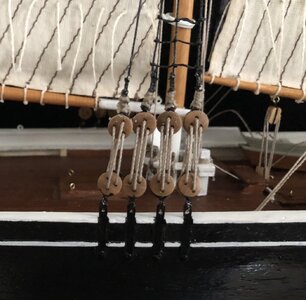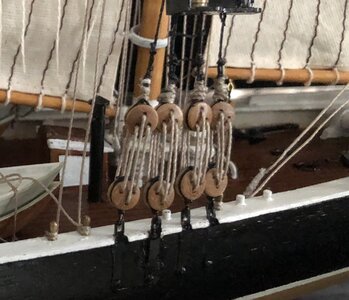I agree with Rich, you’re doing great so far. It’s not easy to come behind someone else and rebuild their ship. Your options are limited, and you seem to be making the best of what you have. I think it will be a nice ship. 
-

Win a Free Custom Engraved Brass Coin!!!
As a way to introduce our brass coins to the community, we will raffle off a free coin during the month of August. Follow link ABOVE for instructions for entering.
You are using an out of date browser. It may not display this or other websites correctly.
You should upgrade or use an alternative browser.
You should upgrade or use an alternative browser.
Rebuilding Bluenose I, BB576. [COMPLETED BUILD]
- Thread starter RDN1954
- Start date
- Watchers 14
-
- Tags
- completed build
- Joined
- Sep 3, 2021
- Messages
- 5,137
- Points
- 738

Thanks, Dean!I agree with Rich, you’re doing great so far. It’s not easy to come behind someone else and rebuild their ship. Your options are limited, and you seem to be making the best of what you have. I think it will be a nice ship.
Luckily I find myself enjoying rebuilding the model and doing some research. I realize I find great satisfaction in learning about the ship itself, but also about the build methods various modelers are using.
And, last but not least, the way fellow modelers help to keep my motivation up to finish the model to the best of my capabilities. It's a fun ride!
Enjoy your Sunday!
Johan
- Joined
- Sep 3, 2021
- Messages
- 5,137
- Points
- 738

See also my reply to Dean.We are all in SoS to support each other. Each one has most likely details that they know about, and others may not have noticed, which they may wish they had done differently or better. For myself I have leaned to accept what I can do which is less than I see in my mind's eye, and move forward . . .while also occasionally having to go back and remove to redo some prior work . . . . maybe even done long ago and now just noticed. You will do well with your build. Rich (PT-2)
- Joined
- Sep 3, 2021
- Messages
- 5,137
- Points
- 738

Oké, this was a beautiful Sunday. First we (the Admiral and I) started the day with a bike ride, 42km/26 miles, on e-bikes, to be frank.
In the afternoon the Admiral saw Hamilton crash into Verstappen (or the other way around, I wouldn't know, LOL) and I continued adding rope hanks and coils to the deck and no, I'm not going to share any pictures yet, first the earlier parts of my journey.
So I had the masts united with the hull again. I drilled the holes for the masts in the decks in accordance with the imprinted diameters on the decks. These holes were slightly larger than the diameters of the masts. This meant I had to fiddle with the shrouds and stays to get the orientation of the masts right. Combine that with the difficulties in getting the shrouds having some tension ánd the desire to get the pitch between the lower- upper deadeyes more or less the same, you're bound to run into trouble.
And that's what I did. It took endless tweaking, doing and redoing the lanyards of the deadeyes, starting again on some of the shrouds and, I must admit, the use of some colorful language. I'm glad no one was around...
In the end I was quite happy with the results; it looks indefinitely better than the original installation with plastic deadeyes. So all shrouds, top and bottom done, up to the next topic... Nope, not gonna happen yet. It was at this point that I definitely got dissatisfied with the BB supplied ropes; they were simply to fluffy, even after using bees wax. So I ordered, after some looking around, some Mantua ropes, in diameters as close as possible to the BB specified rope diameters.
Since I already had some experience with installing the lanyards through te deadeyes, this was fairly easily accomplished. Too bad I couldn't get rid of some remnants of the old ropes, out of fear for damaging the shrouds. I completed the standing rigging by adding the ratlines on the lower shrouds, the upper hrouds were already provided with those lines.
Everyone, who has ever gone through this process, knows how elaborate this task is, yet you have to stay focused. I simplified the knots I used, at least I didn't dare go to the knots as advocated and used by, amongst others, Dean62 on his POF Bluenose build log.
The installation of the stays was pretty straightforward, at least no surprises there, other than, again, it required a lot of tweaking and fiddling to get the tension right, simultaneously making sure the orientations of the masts were correct. Strategy of the day; measure once, measure twice, check and check again!
After completing the installation of the standing rigging, it was time to proceed with the installation of the two jibs and the forward stay sail and the installation of the running rigging.
In the afternoon the Admiral saw Hamilton crash into Verstappen (or the other way around, I wouldn't know, LOL) and I continued adding rope hanks and coils to the deck and no, I'm not going to share any pictures yet, first the earlier parts of my journey.
So I had the masts united with the hull again. I drilled the holes for the masts in the decks in accordance with the imprinted diameters on the decks. These holes were slightly larger than the diameters of the masts. This meant I had to fiddle with the shrouds and stays to get the orientation of the masts right. Combine that with the difficulties in getting the shrouds having some tension ánd the desire to get the pitch between the lower- upper deadeyes more or less the same, you're bound to run into trouble.
And that's what I did. It took endless tweaking, doing and redoing the lanyards of the deadeyes, starting again on some of the shrouds and, I must admit, the use of some colorful language. I'm glad no one was around...
| ||
In the end I was quite happy with the results; it looks indefinitely better than the original installation with plastic deadeyes. So all shrouds, top and bottom done, up to the next topic... Nope, not gonna happen yet. It was at this point that I definitely got dissatisfied with the BB supplied ropes; they were simply to fluffy, even after using bees wax. So I ordered, after some looking around, some Mantua ropes, in diameters as close as possible to the BB specified rope diameters.
Since I already had some experience with installing the lanyards through te deadeyes, this was fairly easily accomplished. Too bad I couldn't get rid of some remnants of the old ropes, out of fear for damaging the shrouds. I completed the standing rigging by adding the ratlines on the lower shrouds, the upper hrouds were already provided with those lines.
Everyone, who has ever gone through this process, knows how elaborate this task is, yet you have to stay focused. I simplified the knots I used, at least I didn't dare go to the knots as advocated and used by, amongst others, Dean62 on his POF Bluenose build log.
The installation of the stays was pretty straightforward, at least no surprises there, other than, again, it required a lot of tweaking and fiddling to get the tension right, simultaneously making sure the orientations of the masts were correct. Strategy of the day; measure once, measure twice, check and check again!
After completing the installation of the standing rigging, it was time to proceed with the installation of the two jibs and the forward stay sail and the installation of the running rigging.
- Joined
- Sep 3, 2021
- Messages
- 5,137
- Points
- 738

Got a belated birthday gift from my son, his wife and my little granddaughter.
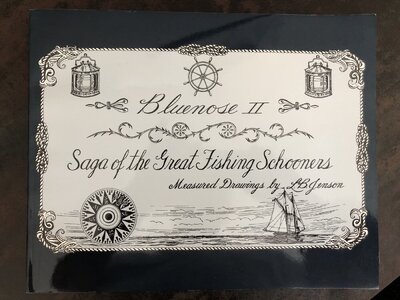
...With an intriguing inscription:
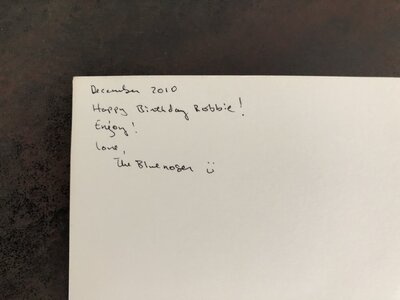
Absolutely thrilled by this present!
Took almost two month before it arrived in the Netherlands from Canada. Didn't know the postal services are still rowing across the Atlantic in dory's... ;-)

...With an intriguing inscription:

Absolutely thrilled by this present!
Took almost two month before it arrived in the Netherlands from Canada. Didn't know the postal services are still rowing across the Atlantic in dory's... ;-)
- Joined
- Sep 3, 2021
- Messages
- 5,137
- Points
- 738

The installation of the running rigging was, to some extent, anti-climatic.
It involved the preparation of the various blocks, attaching blocks to all forms of running rigging ropes, fabricate the termination of said ropes, running ropes through blocks, attaching ropes to the sails and hook the ropes up with the various belaying pins. The running rigging was done from the bow to the stern and where necessary and possible from the centerline to the railing, all under the assumption that it would give me the best possible access.
At this stage, it’s quite essential one has a good picture of all the running rigging, where it’s from and where it’s going. Crossing ropes are to be evaluated closely; one should be very much aware which rope should cross on the inside (or outside) of the other rope. Often the available plans do not show unambiguous how ropes are crossing one another. So you have to use your own common sense and also do some research, although I wasn't able to retrieve much reliable information on this topic.
One also have to be aware from which side of one’s model “the wind is blowing”. The fisherman’s stay sail, for instance, should be positioned at the windward side. On the other hand, the outer jib should be positioned on the leeward side of the jib.
In all honesty, I am not one hundred percent sure about the front- and main gaff sails. Since I also wanted to show the beauty of the running rigging of both gaffs, I had both gaff sails on the leeward side of the schooner sail and the main sail (too bad that the fisherman’s stay sail now obscures the running rigging of the foremasts’ gaff).
I could argue that the lower side of bit gaff sails should be on the windward side, thus receiving support from the gaffs and the schooner-and mainsails.
I already mentioned the coils and hanks I added to the model, so no need to go there again.
Of interest, at least to me, was the fisherman’s stay sail. I decided that it should be present on the model (see my previous posts for some more background information). So I approached Billing Boats, asking whether or not they could supply a separate sail. They responded by advising me to check for the sail cloth with a local supplier and simultaneously, they provided me with a 1:1 drawing for this sail.
First I tried a canvas shopping bag, with the Admiral’s permission. Compared to the other sails the material was way too thin and too translucent and on top of that, it was too dark as well.
So I ordered Amati sail cloth, classic. That was even thinner than the shopping bag material. The color was close, but under certain lighting conditions, it’s a shade or two lighter than the old sails.
After some trial and error, I decided to use two plies of cloth, stitch them together and voilá, a sail was born.
Since I already prepared all the running rigging for this sail, it wasn’t too much of an issue to install the last sail.
Now I’m at the point that the model is restored to a configuration, very close to how it was, when my father completed his build of the Bluenose, except for the hanks and coils and, possibly, the fisherman’s stay sail.
Currently I have some small hardware on order, barrels, buckets, oars. Once those parts have found a place on the model, I’ll declare this project finished.
It's been a very interesting journey, which definitely reignited my interest in building wooden shipmodels.
Since I've been frequenting this site, I have seen the beauty of plank-on-frame building and I am now committed to build another Bluenose, a POF. I can tell you, I haven't even started yet and I'm already nervous, very nervous...

It involved the preparation of the various blocks, attaching blocks to all forms of running rigging ropes, fabricate the termination of said ropes, running ropes through blocks, attaching ropes to the sails and hook the ropes up with the various belaying pins. The running rigging was done from the bow to the stern and where necessary and possible from the centerline to the railing, all under the assumption that it would give me the best possible access.
At this stage, it’s quite essential one has a good picture of all the running rigging, where it’s from and where it’s going. Crossing ropes are to be evaluated closely; one should be very much aware which rope should cross on the inside (or outside) of the other rope. Often the available plans do not show unambiguous how ropes are crossing one another. So you have to use your own common sense and also do some research, although I wasn't able to retrieve much reliable information on this topic.
One also have to be aware from which side of one’s model “the wind is blowing”. The fisherman’s stay sail, for instance, should be positioned at the windward side. On the other hand, the outer jib should be positioned on the leeward side of the jib.
In all honesty, I am not one hundred percent sure about the front- and main gaff sails. Since I also wanted to show the beauty of the running rigging of both gaffs, I had both gaff sails on the leeward side of the schooner sail and the main sail (too bad that the fisherman’s stay sail now obscures the running rigging of the foremasts’ gaff).
I could argue that the lower side of bit gaff sails should be on the windward side, thus receiving support from the gaffs and the schooner-and mainsails.
I already mentioned the coils and hanks I added to the model, so no need to go there again.
Of interest, at least to me, was the fisherman’s stay sail. I decided that it should be present on the model (see my previous posts for some more background information). So I approached Billing Boats, asking whether or not they could supply a separate sail. They responded by advising me to check for the sail cloth with a local supplier and simultaneously, they provided me with a 1:1 drawing for this sail.
First I tried a canvas shopping bag, with the Admiral’s permission. Compared to the other sails the material was way too thin and too translucent and on top of that, it was too dark as well.
So I ordered Amati sail cloth, classic. That was even thinner than the shopping bag material. The color was close, but under certain lighting conditions, it’s a shade or two lighter than the old sails.
After some trial and error, I decided to use two plies of cloth, stitch them together and voilá, a sail was born.
Since I already prepared all the running rigging for this sail, it wasn’t too much of an issue to install the last sail.
Now I’m at the point that the model is restored to a configuration, very close to how it was, when my father completed his build of the Bluenose, except for the hanks and coils and, possibly, the fisherman’s stay sail.
Currently I have some small hardware on order, barrels, buckets, oars. Once those parts have found a place on the model, I’ll declare this project finished.
It's been a very interesting journey, which definitely reignited my interest in building wooden shipmodels.
Since I've been frequenting this site, I have seen the beauty of plank-on-frame building and I am now committed to build another Bluenose, a POF. I can tell you, I haven't even started yet and I'm already nervous, very nervous...

Last edited:
Regarding setting the large stays'l between masts, go back and look at the first thread posting in the group support page #1, tenth photo down shows all sails on port which is a stb'd tack as your spars and sails are set except for the stays'l. A Fisherman's riding sail was a small triangular sail on the main mast/boom that was 1/4 - 1/3 the size of the mains'l and tack tight to the jaws of the boom. Just looking back for you consider how you want to present your schooner. Rich (PT_2)The installation of the running rigging was, to some extent, anti-climatic.
It involved the preparation of the various blocks, attaching blocks to all forms of running rigging ropes, fabricate the termination of said ropes, running ropes through blocks, attaching ropes to the sails and hook the ropes up with the various belaying pins. The running rigging was done from the bow to the stern and where necessary and possible from the centerline to the railing, all under the assumption that it would give me the best possible access.
At this stage, it’s quite essential one has a good picture of all the running rigging, where it’s from and where it’s going. Crossing ropes are to be evaluated closely; one should be very much aware which rope should cross on the inside (or outside) of the other rope. Often the available plans do not show unambiguous how ropes are crossing one another. So you have to use your own common sense and also do some research, although I wasn't able to retrieve much reliable information on this topic.
One also have to be aware from which side of one’s model “the wind is blowing”. The fisherman’s stay sail, for instance, should be positioned at the windward side. On the other hand, the outer jib should be positioned on the leeward side of the jib.
In all honesty, I am not one hundred percent sure about the front- and main gaff sails. Since I also wanted to show the beauty of the running rigging of both gaffs, I had both gaff sails on the leeward side of the schooner sail and the main sail (too bad that the fisherman’s stay sail now obscures the running rigging of the foremasts’ gaff).
I could argue that the lower side of bit gaff sails should be on the windward side, thus receiving support from the gaffs and the schooner-and mainsails.
I already mentioned the coils and hanks I added to the model, so no need to go there again.
Of interest, at least to me, was the fisherman’s stay sail. I decided that it should be present on the model (see my previous posts for some more background information). So I approached Billing Boats, asking whether or not they could supply a separate sail. They responded by advising me to check for the sail cloth with a local supplier and simultaneously, they provided me with a 1:1 drawing for this sail.
First I tried a canvas shopping bag, with the Admiral’s permission. Compared to the other sails the material was way too thin and too translucent and on top of that, it was too dark as well.
So I ordered Amati sail cloth, classic. That was even thinner than the shopping bag material. The color was close, but under certain lighting conditions, it’s a shade or two lighter than the old sails.
After some trial and error, I decided to use two plies of cloth, stitch them together and voilá, a sail was born.
Since I already prepared all the running rigging for this sail, it wasn’t too much of an issue to install the last sail.
Now I’m at the point that the model is restored to a configuration, very close to how it was, when my father completed his build of the Bluenose, except for the hanks and coils and, possibly, the fisherman’s stay sail.
Currently I have some small hardware on order, barrels, buckets, oars. Once those parts have found a place on the model, I’ll declare this project finished.
It's been a very interesting journey, which definitely reignited my interest in building wooden shipmodels.
Since I've been frequenting this site, I have seen the beauty of plank-on-frame building and I am now committed to build another Bluenose, a POF. I can tell you, I haven't even started yet and I'm already nervous, very nervous...
View attachment 257112
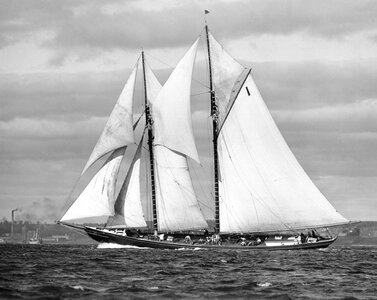
Rich (PT-2)
Great job Johan! No need to be nervous, you just finished the rigging on this ship! That’s half the battle!The installation of the running rigging was, to some extent, anti-climatic.
It involved the preparation of the various blocks, attaching blocks to all forms of running rigging ropes, fabricate the termination of said ropes, running ropes through blocks, attaching ropes to the sails and hook the ropes up with the various belaying pins. The running rigging was done from the bow to the stern and where necessary and possible from the centerline to the railing, all under the assumption that it would give me the best possible access.
At this stage, it’s quite essential one has a good picture of all the running rigging, where it’s from and where it’s going. Crossing ropes are to be evaluated closely; one should be very much aware which rope should cross on the inside (or outside) of the other rope. Often the available plans do not show unambiguous how ropes are crossing one another. So you have to use your own common sense and also do some research, although I wasn't able to retrieve much reliable information on this topic.
One also have to be aware from which side of one’s model “the wind is blowing”. The fisherman’s stay sail, for instance, should be positioned at the windward side. On the other hand, the outer jib should be positioned on the leeward side of the jib.
In all honesty, I am not one hundred percent sure about the front- and main gaff sails. Since I also wanted to show the beauty of the running rigging of both gaffs, I had both gaff sails on the leeward side of the schooner sail and the main sail (too bad that the fisherman’s stay sail now obscures the running rigging of the foremasts’ gaff).
I could argue that the lower side of bit gaff sails should be on the windward side, thus receiving support from the gaffs and the schooner-and mainsails.
I already mentioned the coils and hanks I added to the model, so no need to go there again.
Of interest, at least to me, was the fisherman’s stay sail. I decided that it should be present on the model (see my previous posts for some more background information). So I approached Billing Boats, asking whether or not they could supply a separate sail. They responded by advising me to check for the sail cloth with a local supplier and simultaneously, they provided me with a 1:1 drawing for this sail.
First I tried a canvas shopping bag, with the Admiral’s permission. Compared to the other sails the material was way too thin and too translucent and on top of that, it was too dark as well.
So I ordered Amati sail cloth, classic. That was even thinner than the shopping bag material. The color was close, but under certain lighting conditions, it’s a shade or two lighter than the old sails.
After some trial and error, I decided to use two plies of cloth, stitch them together and voilá, a sail was born.
Since I already prepared all the running rigging for this sail, it wasn’t too much of an issue to install the last sail.
Now I’m at the point that the model is restored to a configuration, very close to how it was, when my father completed his build of the Bluenose, except for the hanks and coils and, possibly, the fisherman’s stay sail.
Currently I have some small hardware on order, barrels, buckets, oars. Once those parts have found a place on the model, I’ll declare this project finished.
It's been a very interesting journey, which definitely reignited my interest in building wooden shipmodels.
Since I've been frequenting this site, I have seen the beauty of plank-on-frame building and I am now committed to build another Bluenose, a POF. I can tell you, I haven't even started yet and I'm already nervous, very nervous...
View attachment 257112
- Joined
- Sep 3, 2021
- Messages
- 5,137
- Points
- 738

Ritch,Regarding setting the large stays'l between masts, go back and look at the first thread posting in the group support page #1, tenth photo down shows all sails on port which is a stb'd tack as your spars and sails are set except for the stays'l. A Fisherman's riding sail was a small triangular sail on the main mast/boom that was 1/4 - 1/3 the size of the mains'l and tack tight to the jaws of the boom. Just looking back for you consider how you want to present your schooner. Rich (PT_2)View attachment 257184
Rich (PT-2)
What a beauty to behold under full sail!
As far as the naming and orientation of the sails go; I used, amongst others, the definition by Wikipedia and the picture below for naming convention and the orientation of the stay sail. There is quite some pictorial evidence though for having the staysail on either windward or leeward side.
Thinking things through again made me realize that, once set, one would probably not lower the staysail
before tacking and reset it again after tacking is completed, although again, other sources mention the staysail will be lowered and set again after each tacking.
I think I will leave it for the time being, see if, as a whole, the model stays pleasing enough on the eyes.
Thanks for your remarks tough; it makes me go through my decision making process again and re-check the sources I used.
Johan
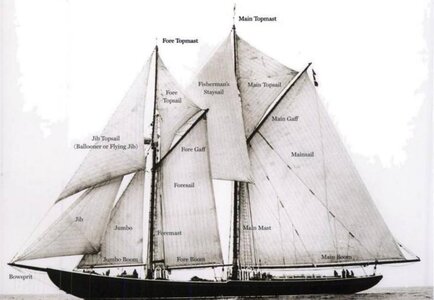
Wiki as I recall is an open forum and seeks corrections for many things. I got my sail naming from other schooner resources and for a model it is not that important as it is the physical model that we want and not text. . . IMHO. RichRitch,
What a beauty to behold under full sail!
As far as the naming and orientation of the sails go; I used, amongst others, the definition by Wikipedia and the picture below for naming convention and the orientation of the stay sail. There is quite some pictorial evidence though for having the staysail on either windward or leeward side.
Thinking things through again made me realize that, once set, one would probably not lower the staysail
before tacking and reset it again after tacking is completed, although again, other sources mention the staysail will be lowered and set again after each tacking.
I think I will leave it for the time being, see if, as a whole, the model stays pleasing enough on the eyes.
Thanks for your remarks tough; it makes me go through my decision making process again and re-check the sources I used.
Johan
View attachment 257197
- Joined
- Sep 3, 2021
- Messages
- 5,137
- Points
- 738

Wiki is indeed an open forum, with sometimes biased or even outright wrong information, so you're right, one should not put one's faith in Wiki.
Luckily, we have other resources, like the treasure trove "Saga of the Great Fishing Schooners"!
Some words on sails being positioned windward or leeway. Again a lot of information can be found on various websites. I did some research on this topic and I came across information, strongly suggesting the windward side position. Initially I was set for the leeway, but based on the newly found facts/opinions(?), I changed my mind. So I put on the staysail accordingly.
Further triggered by Ritch remarks I did some more research and evidence of gaff top- and stay sails being on either side can be found. So essentially it comes down to our own choices/preferences.
I can truthfully say I'm quite pleased with the results so far, the model looks great to me. Right now the model is sitting in our living room and it's definitely an eye catcher. I'm really happy I picked up the gauntlet and brought the model back to life.
Now still some final touches to add here and there, followed by an unrelated side project and than..... the next modeling journey!
Johan
Luckily, we have other resources, like the treasure trove "Saga of the Great Fishing Schooners"!
Some words on sails being positioned windward or leeway. Again a lot of information can be found on various websites. I did some research on this topic and I came across information, strongly suggesting the windward side position. Initially I was set for the leeway, but based on the newly found facts/opinions(?), I changed my mind. So I put on the staysail accordingly.
Further triggered by Ritch remarks I did some more research and evidence of gaff top- and stay sails being on either side can be found. So essentially it comes down to our own choices/preferences.
I can truthfully say I'm quite pleased with the results so far, the model looks great to me. Right now the model is sitting in our living room and it's definitely an eye catcher. I'm really happy I picked up the gauntlet and brought the model back to life.
Now still some final touches to add here and there, followed by an unrelated side project and than..... the next modeling journey!
Johan
Last edited:
You do have a very nice model and hopefully had a good time in the voyage. RichWiki is indeed an open forum, with sometimes biased or even outright wrong information, so you're right, one should not put one's faith in Wiki.
Luckily, we have other resources, like the treasure trove "Saga of the Great Fishing Schooners"!
Some words on sails being positioned windward or leeway. Again a lot of information can be found on various websites. I did some research on this topic and I came across information, strongly suggesting the windward side position. Initially I was set for the leeway, but based on the newly found facts/opinions(?), I changed my mind. So I put on the staysail accordingly.
Further triggered by Ritch remarks I did some more research and evidence of gaff top- and stay sails being on either side can be found. So essentially it comes down to our own choices/preferences.
I can truthfully say I'm quite pleased with the results so far, the model looks great to me. Right now the model is sitting in our living room and it's definitely an eye catcher. I'm really happy I picked up the gauntlet and brought the model back to life.
Now still some final touches to add here and there, followed by an unrelated side project and than..... the next modeling journey!
Johan
- Joined
- Sep 3, 2021
- Messages
- 5,137
- Points
- 738

Today I added some accessories to give the Bluenose model some more appeal.
Oars were added to the dories, a bucket, barrels, three wooden and a metallic one, in front of the main cabin and a bucket on the rear deck, close to the stern.
This signifies the end of my journey, rebuilding my "shipwrecked" model.
I immensely enjoyed this rebuild, looking for (historical) information of the Bluenose, reading the various build logs on internet and, last but not least, becoming a member of Ships of Scale.
Also appreciated were the advices you shared with me, your visions, comments and most of all your uplifting reactions.
So this (re) build log closes, no more updates, but... The beginning of next year will see the start of a new build; I will be starting the build ( and of course a build log) of a YQ POF Bluenose model.
So thanks again for all your reactions!
Stay safe,
Johan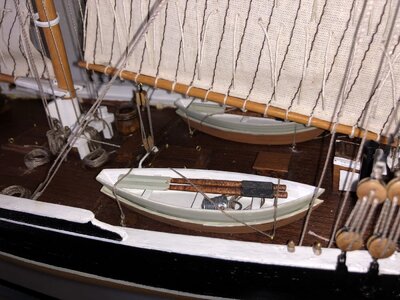
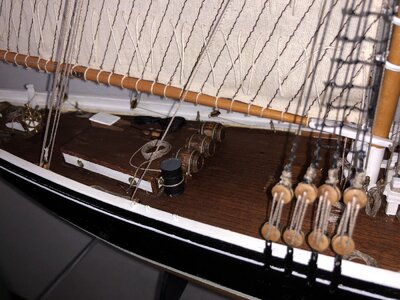
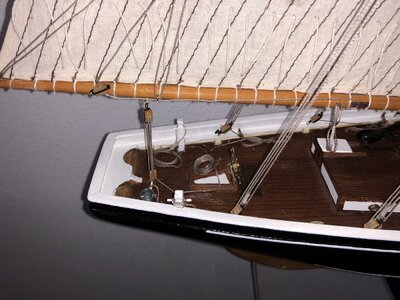
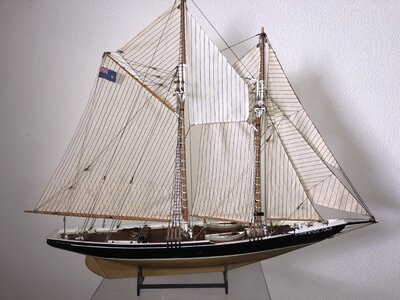
Oars were added to the dories, a bucket, barrels, three wooden and a metallic one, in front of the main cabin and a bucket on the rear deck, close to the stern.
This signifies the end of my journey, rebuilding my "shipwrecked" model.
I immensely enjoyed this rebuild, looking for (historical) information of the Bluenose, reading the various build logs on internet and, last but not least, becoming a member of Ships of Scale.
Also appreciated were the advices you shared with me, your visions, comments and most of all your uplifting reactions.
So this (re) build log closes, no more updates, but... The beginning of next year will see the start of a new build; I will be starting the build ( and of course a build log) of a YQ POF Bluenose model.
So thanks again for all your reactions!
Stay safe,
Johan




Great job Johan! She is beautiful! Looking forward to your POF build of the BN.Today I added some accessories to give the Bluenose model some more appeal.
Oars were added to the dories, a bucket, barrels, three wooden and a metallic one, in front of the main cabin and a bucket on the rear deck, close to the stern.
This signifies the end of my journey, rebuilding my "shipwrecked" model.
I immensely enjoyed this rebuild, looking for (historical) information of the Bluenose, reading the various build logs on internet and, last but not least, becoming a member of Ships of Scale.
Also appreciated were the advices you shared with me, your visions, comments and most of all your uplifting reactions.
So this (re) build log closes, no more updates, but... The beginning of next year will see the start of a new build; I will be starting the build ( and of course a build log) of a YQ POF Bluenose model.
So thanks again for all your reactions!
Stay safe,
Johan View attachment 260037
View attachment 260038
View attachment 260039View attachment 260040
Very nicely done and detailed. Congratulations upon your work. RIch (PT-2)Today I added some accessories to give the Bluenose model some more appeal.
Oars were added to the dories, a bucket, barrels, three wooden and a metallic one, in front of the main cabin and a bucket on the rear deck, close to the stern.
This signifies the end of my journey, rebuilding my "shipwrecked" model.
I immensely enjoyed this rebuild, looking for (historical) information of the Bluenose, reading the various build logs on internet and, last but not least, becoming a member of Ships of Scale.
Also appreciated were the advices you shared with me, your visions, comments and most of all your uplifting reactions.
So this (re) build log closes, no more updates, but... The beginning of next year will see the start of a new build; I will be starting the build ( and of course a build log) of a YQ POF Bluenose model.
So thanks again for all your reactions!
Stay safe,
Johan View attachment 260037
View attachment 260038
View attachment 260039View attachment 260040
Also from my side congratulations for Finishing her.
You built a very Fine model
You built a very Fine model
- Joined
- Sep 3, 2021
- Messages
- 5,137
- Points
- 738

Thank you so much, kind sir!Also from my side congratulations for Finishing her.
You built a very Fine model
- Joined
- Sep 3, 2021
- Messages
- 5,137
- Points
- 738

Thanks Heinrich, I enjoyed my re-introduction in modeling.Congratulations on what is a fine achievement Johan! Like Dean said, you do not have to be nervous about the POF Bluenose at all. We are waiting for January 2022 in anticipation!
Still nervous about entering the POF world, especially when going through the build logs...
- Joined
- Sep 3, 2021
- Messages
- 5,137
- Points
- 738

Thanks Rich, it sure was a learning experience, especially since there is so much more information available at the touch of a finger. Forty years back one was lucky if here was any information at al to be found in a local, small town library.Very nicely done and detailed. Congratulations upon your work. RIch (PT-2)

